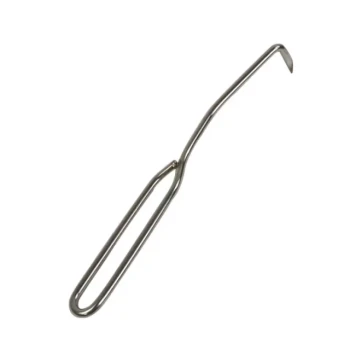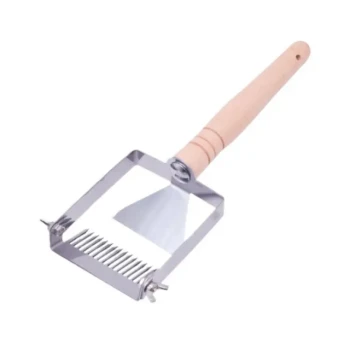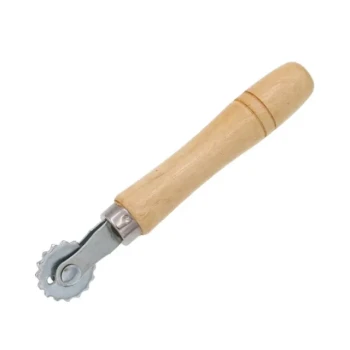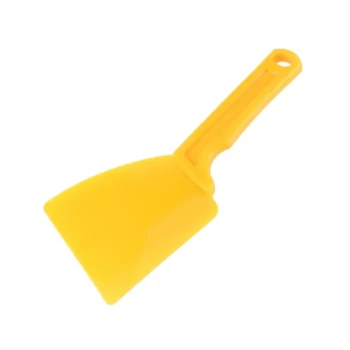As the seasons turn, your focus as a beekeeper shifts from harvesting honey to ensuring survival. Your primary tasks in the fall are to remove excess honey supers, ensure the colony has a healthy queen and a very low Varroa mite population, and consolidate the hive to a size that the bees can defend and keep warm. Most importantly, you must verify the colony has enough honey stored to last through winter, and be prepared to feed them if they are short.
Successful fall management is not a single action but a comprehensive strategy to prepare your colony for the harsh conditions ahead. It rests on three pillars: ensuring a healthy population, securing ample food stores, and creating a defensible, weatherproof home.
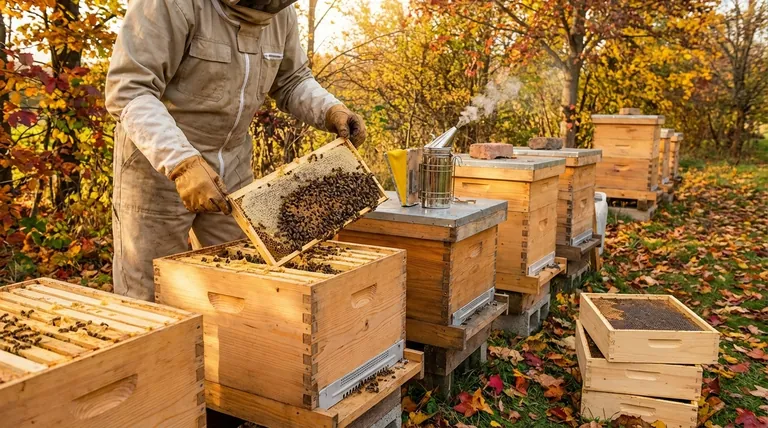
Assessing and Strengthening the Winter Population
The bees that are raised in the fall are the same bees that must survive the entire winter. Their health is paramount.
The Importance of a Healthy Queen
A strong queen is crucial. In early fall, you should inspect the brood nest to confirm she is still laying eggs, creating the "winter bees" that will sustain the colony.
Her laying pattern should be compact and consistent. A spotty or sparse brood pattern can signal a failing queen, which is a near-certain death sentence for the colony if not addressed.
The Critical Task of Varroa Mite Control
Varroa destructor mites are the single greatest threat to overwintering colonies. Mite populations peak in the fall, feeding on both adult bees and developing brood.
Bees entering winter that have been parasitized by mites have weakened immune systems and shorter lifespans. It is essential to test your mite levels in late summer or early fall and apply an appropriate treatment to ensure the winter bees are born into a low-mite environment.
Combining or Boosting Weak Hives
A small cluster of bees has a very difficult time generating enough heat to survive a cold winter. A weak colony with a small population heading into fall is unlikely to make it.
If you have a weak hive, the best course of action is often to combine it with a stronger one using the newspaper method. This sacrifices one colony to ensure the survival and strength of the other.
Securing Adequate Food Stores
Honey is the carbohydrate fuel bees use to generate heat. Without enough of it, they will freeze and starve.
How Much Honey Is Enough?
A standard rule of thumb is that a full-sized colony needs approximately 60-90 pounds (27-41 kg) of honey to survive winter in a cold climate. This is roughly equivalent to a full, heavy deep brood box.
The specific amount depends on your climate's severity and the length of your winter. A hive in a milder climate may need significantly less. You can assess stores by lifting the back of the hive; it should feel very heavy.
When and How to Feed
If your hive feels light or inspections reveal insufficient honey, you must feed them. Fall feeding should be done with a 2:1 sugar-to-water syrup (two parts sugar, one part water by weight).
This thick syrup mimics honey and encourages the bees to store it quickly rather than consume it for brood rearing. Feeding should be completed before the daytime temperatures consistently drop below 50°F (10°C), as bees will be unable to process the syrup in cold weather.
Preparing the Physical Hive for Winter
The final step is to ensure the hive itself is a secure fortress against winter's challenges.
Consolidating the Hive
Remove all empty or mostly empty boxes, including queen excluders and honey supers. The goal is to reduce the hive to the smallest space the bees can realistically occupy, typically one or two deep brood boxes.
This smaller space is easier for the bees to keep warm and defend from pests. Any frames of honey from the removed supers can be placed in the brood boxes, positioned towards the outside of the nest.
Installing Entrance Reducers and Mouse Guards
With a smaller population and cold temperatures, the colony is vulnerable. An entrance reducer should be placed on the smallest opening to help the bees defend against robbing from other hives.
A mouse guard, a strip of hardware cloth with bee-sized openings, should be installed over the entrance. This prevents mice from entering the hive to seek warmth and build nests, which would destroy comb and harass the bees.
Providing Ventilation and Weatherproofing
While a sealed home is important, ventilation is critical. Moisture created by the bees' respiration can condense on cold inner surfaces, dripping down on the cluster and chilling them.
Ensure you have a small upper entrance or a ventilated inner cover to allow this moist air to escape. Also, check that the outer cover is sound and the hive is tilted slightly forward so water runs off the front and does not seep inside.
Understanding the Trade-offs
Every management decision comes with consequences. Being aware of them is key to making the right choice.
The Risk of Feeding Too Late
Feeding syrup in cold weather is ineffective. The bees cannot break it down, and the excess moisture it adds to the hive is dangerous. If you discover a starving colony mid-winter, you must use solid food like fondant or sugar cakes, not liquid syrup.
The Danger of Leaving Too Much Space
Leaving on extra supers "just in case" is a common and serious mistake. Excess space is impossible for a shrinking bee cluster to heat. This leads to wasted energy and makes the colony more susceptible to the cold.
The Consequence of Ignoring Mites
Many beekeepers believe their hives are mite-free without testing. This is rarely true. A colony that goes into winter with a high mite load may seem strong in November but will likely collapse by February. Fall mite treatment is non-negotiable for long-term success.
Making the Right Choice for Your Colony
Your specific actions should be tailored to your climate and the condition of your hive.
- If you are in a cold climate with a long winter: Prioritize maximizing honey stores to at least 80-90 pounds and perform a robust mite treatment after the main honey flow.
- If you have a weaker hive with a good queen: Consider boosting it with frames of brood from a stronger hive, but only if the donor hive can spare them.
- If your bees are light on stores late in the season: Begin feeding a heavy 2:1 syrup immediately and continue until they have stored enough to feel heavy.
- If you see a spotty brood pattern: Your best option is to requeen immediately or combine the hive with a queen-right colony before it's too late.
Your diligence in the fall directly determines the strength and success of your bees next spring.
Summary Table:
| Key Fall Management Task | Why It's Critical | Key Action |
|---|---|---|
| Varroa Mite Control | Mites weaken winter bees, leading to colony collapse. | Test mite levels and apply a fall treatment. |
| Assess Food Stores | Bees need 60-90 lbs of honey to generate heat and survive. | Lift the hive; feed 2:1 sugar syrup if light. |
| Hive Consolidation | A smaller space is easier for the cluster to heat and defend. | Remove empty supers; reduce to 1-2 brood boxes. |
| Weatherproofing | Protects against cold, moisture, and pests like mice. | Install entrance reducers, mouse guards, and ensure ventilation. |
Ensure your apiary is prepared for a successful winter with HONESTBEE.
We supply commercial apiaries and beekeeping equipment distributors with the high-quality, durable supplies needed for effective fall management—from mite treatments and feeders to essential winterizing equipment. Our wholesale-focused operations are designed to support your scale and success.
Contact our team today to discuss your seasonal supply needs and secure the right equipment for your colonies.
Visual Guide
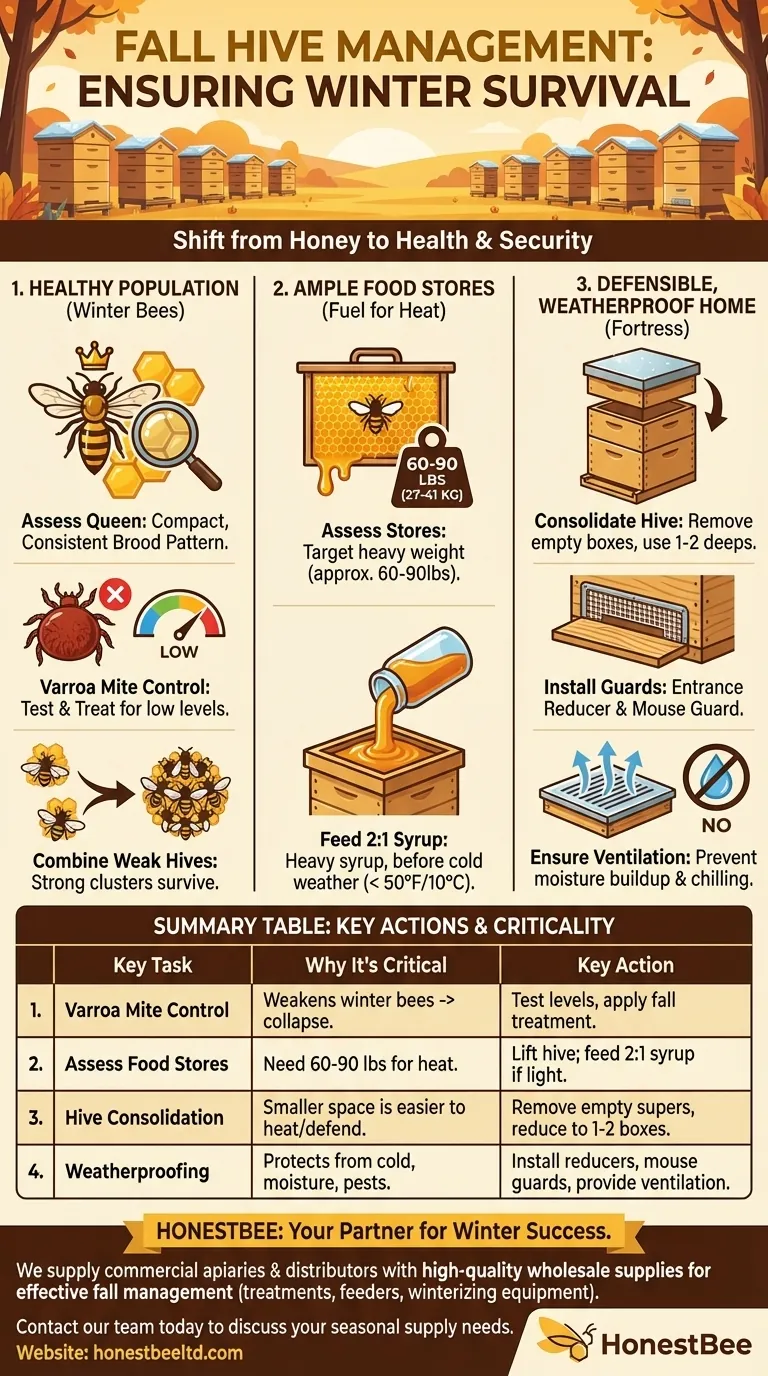
Related Products
- Professional Bee Smoker with Elongated Spout and Durable Bellows for Beekeeping
- Ventilated Adult Beekeeping Helmet Hat for Beekeepers
- Long Langstroth Style Horizontal Top Bar Hive for Wholesale
- Professional Insulated Winter Hive Wrap for Beekeeping
- Professional Multi-Function Stainless Steel Hive Tool
People Also Ask
- Why is smoke used when harvesting honey? Safely Manage Your Hive with Proven Techniques
- Does smoke affect bees? Uncover the Secret to Calming Your Hive Safely
- How does smoking bees affect their behavior? Unlock the Secret to Calm, Manageable Hives
- How does smoke affect honey? Balancing Bee Safety and Honey Purity
- What is a bee smoker and how does it work? Master the Tool for Calm, Safe Hive Inspections








